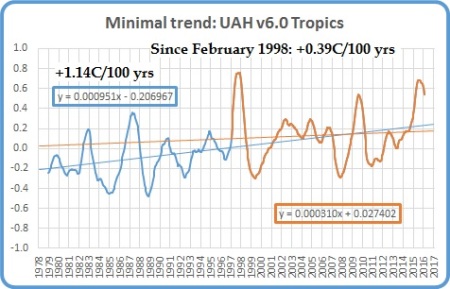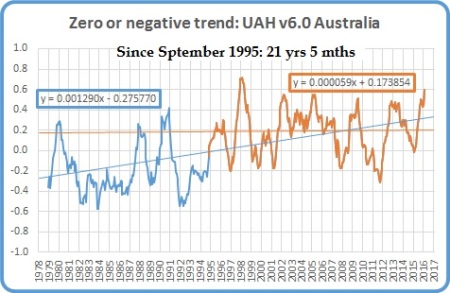The complete UAH v6.0 data for January have been released. I present all the graphs for various regions, and as well summaries for easier comparison. I also include graphs for the North and South Temperate regions (20-60 North and South), estimated from Polar and Extra-Tropical data.
The Pause has ended globally and for all regions including the USA and the Southern Hemisphere, except for Southern Extra-Tropics, South Temperate, South Polar, and Australia. The 12 month mean to January 2017 for the Globe is +0.48 C.
These graphs show the furthest back one can go to show a zero or negative trend (less than 0.1 +/-0.1C per 100 years) in lower tropospheric temperatures. I calculate 12 month running means to remove the small possibility of seasonal autocorrelation in the monthly anomalies. Note: The satellite record commences in December 1978- now 38 years and two months long- 458 months. 12 month running means commence in November 1979. The y-axes in the graphs below are at December 1978, so the vertical gridlines denote Decembers. The final plotted points are January 2017.
[CLICK ON IMAGES TO ENLARGE]
Globe:

The Pause has ended. A trend of +0.36 C/100 years (+/- 0.1C) since March 1998 is creeping up, but the 12 month means have peaked and are heading down.
And, for the special benefit of those who think that I am deliberately fudging data by using 12 month running means, here is the plot of monthly anomalies:

That’s since December 1997.
Northern Hemisphere:

The Northern Hemisphere Pause has well and truly ended.
Southern Hemisphere:

The Pause has ended- just.
Tropics:

The Pause in the Tropics (20N to 20S) has ended and the minimal trend is now +.39C/ 100 years. 12 month means are dropping fast.
As Tropical Oceans closely mimic the Tropics overall, I won’t show their plot.
Northern Extra Tropics:

The minimal trend is up to +0.64C/ 100 years= that’s one degree less than the whole trend.
Northern Temperate Region:

Using estimates calculated from North Polar and Northern Extra-Tropics data, while the trend since June 1998 of +0.28 +/- 0.1C per 100 years is more than my criterion for a Pause, it is 1.2C less than the trend for the whole period. The slowdown is obvious, and for Land areas the trend is zero.
Southern Extra Tropics:

The Pause persists strongly, however 12 month means are still rising, and the Pause may shorten or even disappear.
Southern Temperate Region:

Using estimates calculated from South Polar and Southern Extra-Tropics data, the Pause is shorter than for Southern Extra-Tropics.
Northern Polar:

The trend has increased rapidly and will continue to do so even though 12 month means have started to fall.
Southern Polar:

The South Polar region has been cooling for the entire record. With 12 month means still rising, this cooling trend will slow over the next few months.
USA 49 States:

The Pause has ended- just. It will not re-appear for some time.
Australia:

The Pause is still 21 years 5 months. Heat in recent weeks may push the 12 month mean higher and shorten the Pause. (September, oops!)
The next graphs summarise the above plots. First, a graph of the relative length of The Pause in the various regions:

Note that the Pause has ended by my criteria in all regions of Northern Hemisphere, and consequently the Globe, and the Tropics, but all southern regions have a Pause for over half the record, including the South Polar region which has been cooling for the whole record. Note that the Tropic influence has been enough to end the Pause for the Southern Hemisphere.
The variation in the linear trend for the whole record, 1978 to the present:

Note the decrease in trends from North Polar to South Polar.
And the variation in the linear trend since June 1998, which is about halfway between the global low point of December 1997 and the peak in December 1998:

The imbalance between the two hemispheres is obvious. The lower troposphere over Australia has been strongly cooling for more than 18 years- just shy of half the record.
The Pause has disappeared from the USA and Southern Hemisphere, but not the Southern Extra-Tropics, South Temperate, and South Polar regions, or Australia. El Nino tropical heat is rapidly decreasing, with all northern means falling, but will continue to affect the Southern Hemisphere in coming months. Global TLT anomalies are now dropping rapidly. The next few months will be interesting.
















